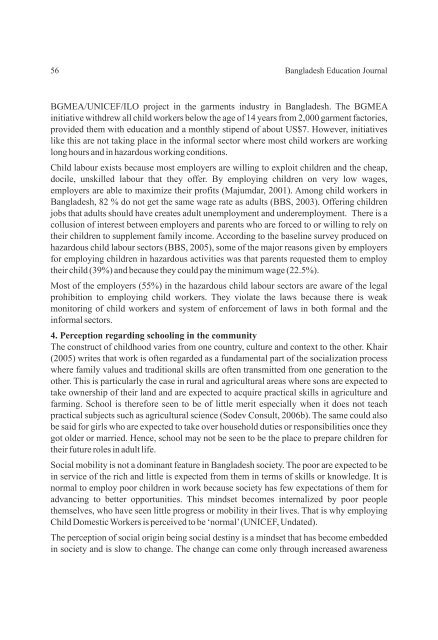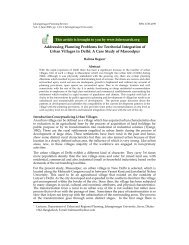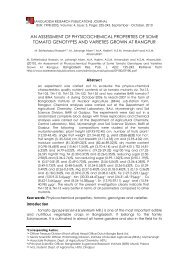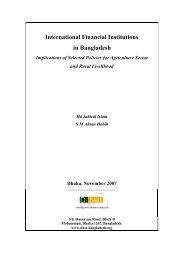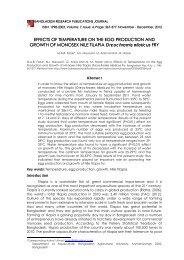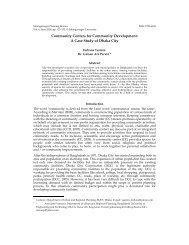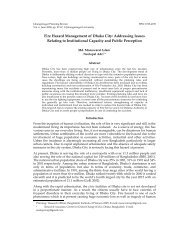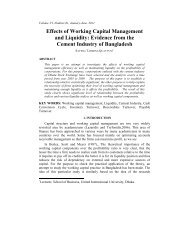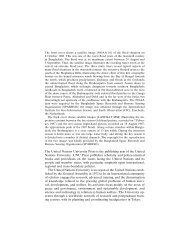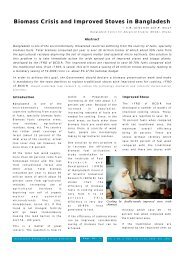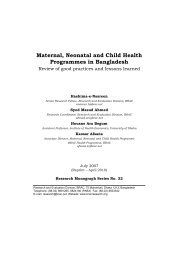Child Labour and Education in Bangladesh - Bangladesh Online ...
Child Labour and Education in Bangladesh - Bangladesh Online ...
Child Labour and Education in Bangladesh - Bangladesh Online ...
Create successful ePaper yourself
Turn your PDF publications into a flip-book with our unique Google optimized e-Paper software.
56 <strong>Bangladesh</strong> <strong>Education</strong> JournalBGMEA/UNICEF/ILO project <strong>in</strong> the garments <strong>in</strong>dustry <strong>in</strong> <strong>Bangladesh</strong>. The BGMEA<strong>in</strong>itiative withdrew all child workers below the age of 14 years from 2,000 garment factories,provided them with education <strong>and</strong> a monthly stipend of about US$7. However, <strong>in</strong>itiativeslike this are not tak<strong>in</strong>g place <strong>in</strong> the <strong>in</strong>formal sector where most child workers are work<strong>in</strong>glong hours <strong>and</strong> <strong>in</strong> hazardous work<strong>in</strong>g conditions.<strong>Child</strong> labour exists because most employers are will<strong>in</strong>g to exploit children <strong>and</strong> the cheap,docile, unskilled labour that they offer. By employ<strong>in</strong>g children on very low wages,employers are able to maximize their profits (Majumdar, 2001). Among child workers <strong>in</strong><strong>Bangladesh</strong>, 82 % do not get the same wage rate as adults (BBS, 2003). Offer<strong>in</strong>g childrenjobs that adults should have creates adult unemployment <strong>and</strong> underemployment. There is acollusion of <strong>in</strong>terest between employers <strong>and</strong> parents who are forced to or will<strong>in</strong>g to rely ontheir children to supplement family <strong>in</strong>come. Accord<strong>in</strong>g to the basel<strong>in</strong>e survey produced onhazardous child labour sectors (BBS, 2005), some of the major reasons given by employersfor employ<strong>in</strong>g children <strong>in</strong> hazardous activities was that parents requested them to employtheir child (39%) <strong>and</strong> because they could pay the m<strong>in</strong>imum wage (22.5%).Most of the employers (55%) <strong>in</strong> the hazardous child labour sectors are aware of the legalprohibition to employ<strong>in</strong>g child workers. They violate the laws because there is weakmonitor<strong>in</strong>g of child workers <strong>and</strong> system of enforcement of laws <strong>in</strong> both formal <strong>and</strong> the<strong>in</strong>formal sectors.4. Perception regard<strong>in</strong>g school<strong>in</strong>g <strong>in</strong> the communityThe construct of childhood varies from one country, culture <strong>and</strong> context to the other. Khair(2005) writes that work is often regarded as a fundamental part of the socialization processwhere family values <strong>and</strong> traditional skills are often transmitted from one generation to theother. This is particularly the case <strong>in</strong> rural <strong>and</strong> agricultural areas where sons are expected totake ownership of their l<strong>and</strong> <strong>and</strong> are expected to acquire practical skills <strong>in</strong> agriculture <strong>and</strong>farm<strong>in</strong>g. School is therefore seen to be of little merit especially when it does not teachpractical subjects such as agricultural science (Sodev Consult, 2006b). The same could alsobe said for girls who are expected to take over household duties or responsibilities once theygot older or married. Hence, school may not be seen to be the place to prepare children fortheir future roles <strong>in</strong> adult life.Social mobility is not a dom<strong>in</strong>ant feature <strong>in</strong> <strong>Bangladesh</strong> society. The poor are expected to be<strong>in</strong> service of the rich <strong>and</strong> little is expected from them <strong>in</strong> terms of skills or knowledge. It isnormal to employ poor children <strong>in</strong> work because society has few expectations of them foradvanc<strong>in</strong>g to better opportunities. This m<strong>in</strong>dset becomes <strong>in</strong>ternalized by poor peoplethemselves, who have seen little progress or mobility <strong>in</strong> their lives. That is why employ<strong>in</strong>g<strong>Child</strong> Domestic Workers is perceived to be ‘normal’ (UNICEF, Undated).The perception of social orig<strong>in</strong> be<strong>in</strong>g social dest<strong>in</strong>y is a m<strong>in</strong>dset that has become embedded<strong>in</strong> society <strong>and</strong> is slow to change. The change can come only through <strong>in</strong>creased awareness


